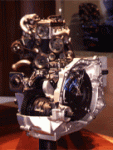The wife saw a cute Clio auto yesterday & thought it looked cool.
Do these Renault transmissions have a good/bad reputation?
I think she has a soft spot for Renaults as an R12 was her first car (also, I taught her to drive in it - but this is not recommended!)
Do these Renault transmissions have a good/bad reputation?
I think she has a soft spot for Renaults as an R12 was her first car (also, I taught her to drive in it - but this is not recommended!)


 )....
)....